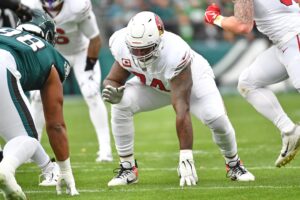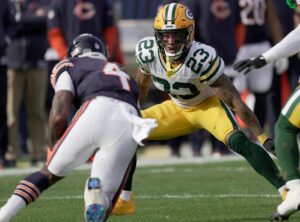Battling an opponent who is down, out, and swindling in mediocrity is also known as a trap game. Trap games, however, are more about trends coming to fruition than any sort of ‘magical’ will imposing tragedy upon a team. In the world of sports, everyone has a bad game, but those who fall in trap games usually reveal some of their intrinsic weaknesses in that loss. Hence, trap games ought to be labeled evaluation games. The quietness surrounding the game, the lack of attention, a lack of focus on preparing for the game is akin to walking into a test and chalking it up to the best of the past without studying the new knowledge. And thus, weaknesses will shine through, unless that new knowledge is aptly used.
Under that notion, the Kansas City Chiefs will be defending Arrowhead Stadium from the Miami Dolphins – a team wallowing in mediocrity and inconsistency. However, the Jay Culter-led Dolphins have been sporadically opportune at time. The Chiefs have rebounded their identity over the past week, and become a nuanced team in slight revitalization of their traditional schematics. Yet, just as students who walk into a test resting on the laurels of the past, without putting revitalization to apt use, failure is in store. The Kansas City Chiefs week 16 scheme ought to rely on consistently improving their best assets while continuously mitigating weaknesses. Week 16 could provide a priming game to refine the best of the December Chiefs.
Kansas City Chiefs Week 16 Scheme Breakdown – Refining A Winning Methodology
Three Tenants to Offense
Over the past three weeks, the Chiefs offense has refined themselves under three succinct concepts: First, Kareem Hunt runs the ball primarily through the interior, but also pulling and trap runs to the outside. Second, Matt Nagy has evolved the passing tree to set up Alex Smith for success with routes that go into a window, not an intrinsic check-down. Third, Tyreek Hill and Travis Kelce are being used more in isolation sets to let speed and physicality respectively dominate.
Under those three tenants, the Chiefs will be able to improve and ride into the playoffs. However, first, they need to refine their winning methodology against the Dolphins defense. It’s a unit built on physically forcing other teams to make mistakes. Philosophically, the Dolphins find the holes in their opponent’s strategy and extrapolate upon those. While that is a sort of identity in itself (physicality), the philosophy does not properly utilize a full breadth of the players on the roster.
The original concept of the 2017 Dolphins defense is born on an incomplete Vance Joseph concept from the 2016 season. Joseph went on to coach the Denver Broncos after improving the Dolphins defense. And although the Dolphins improved on some of their philosophical tenants, they also failed to complete the ideas before handing the defense off to Matt Burke.
The schematic philosophy is built off the defensive line being able to align appropriately under the wide nine-front. Therefore, Ndamukong Suh and Jordan Phillips take the interior gaps, while Cameron Wake and Andre Branch take the objective exterior lines. Albeit, Suh and Phillips also possess flexibility and athleticism to emphasize the ability for the scheme to adjust to multiple attacks.
Suh takes the responsibility of swallowing the run plays to the strength side, putting emphasis on double teams between center Zach Fulton and either guard Laurent Duvernay-Tardif or Bryan Witzmann to open running lanes. The Chiefs operate out of a bevy of straight forward power run sets, but may option for more pulling plays or weak side runs this week. They have shown the ability to vary their running style and succeed.
The outside pass rush is contra prose to the Chiefs concept. Using the wide nine is more about squeezing the pocket than using pure speed. Wake is a power asset, while Branch has both power and finesse. They drafted rookie Charles Harris to grow into a speed role, but he has only netted one sack. The most success the Dolphins defense has had is letting Wake power around offensive tackles instead of relying on blitzing.
Which brings up the linebackers, a position the Dolphins have built on Kiko Alonso operating as a quasi-Tampa Two linebacker in the emphatic middle linebacker spot. Alonso is an athlete, not a powerful blitz backer. Ideally, the Dolphins should operate with a linebacker who can take on their gap assignment with strength. Alonso cannot, hence the importance of Suh demanding thorough double teams.
As soon as an offensive lineman comes off their man and hits Alonso, the run defense devolves into a mess. Therefore, if the front three lineman take care of their assignments, the Chiefs ground attack could have one of its best games on Sunday.
The other linebackers, Chase Allen and Lawrence Timmons, also have trouble bringing blitzes, and thus Wake will often be seen aligned on a strong side, slightly off the line as a linebacker. In some concepts, and specifically on passing downs, the Dolphins utilize a two-linebacker set to bring in a third corner to alleviate the pressure put on their linebackers.
Double and triple tight end sets can puncture the Dolphins line. Isolating Kelce, Albert Wilson, or any other athlete for that matter, on one of the linebackers using motion will force the linebackers to widen out and align in a dreadful mismatch. Further, those sets can also open one or two draw runs with an open middle field.
From Kelce to Orson Charles, the Chiefs can use those isolation concepts to work as the essential routes throughout the entire tenure of the game. Furthermore, Hill can motion into the backfield and be utilized on swing routes to further embarrass the Dolphins linebackers.
Yet, Hill also has potential against the Dolphins cornerback heavy sets. Any time the Dolphins option to heavier corner sets, they utilize bump and run coverage on the exterior, while using a cover one out of the big nickel. The extra nickel corner is usually a stronger safety who can intrinsically assist in a physical coverage style. Thus, that extra safety may remove Kelce from different offensive plays.
Removing Kelce from the intrinsic deep ball is implicative of him running more dig and under routes. Kelce and Hill, however, connect their deep route concepts with Kelce as the decoy and Hill as the isolation on the outside. Time and time again Hill has been featured as the exterior receiver who can tear apart single-man, bump and run coverage.
The Dolphins have no hope of stopping with that type of coverage. Nor do they have hope of stopping him on softer, under routes if they adjust by aligning slightly off. Hence, curl routes or quick in-routes will paint Hill as the primary receiver. At the end of the day, the hope of the Dolphins relies on a fascinating alignment of Pro-Bowl safety Reshad Jones in coverage of Chiefs Pro-Bowlers Hill and Kelce.
Pressure From the Interior
The Dolphins offense and the Chiefs defense is a battle featuring two units who have flashed at times, while wallowing in their own demise at others. Part of the Dolphins problem is the fact they have utilized two different quarterbacks after Ryan Tannehill tore his ACL in the pre-season. Both Cutler and Matt Moore have come in not to lead an offense in stability, but to associate the adjective chaos with their operation.
Tannehill ideally operates in the same manner that Smith operates in: a plethora of safe throws, but more ability than Smith to go over the top to Jarvis Landry and DeVante Parker. Cutler attempted to come in and suffice that role, but due to his history with head coach Adam Gase, the two attempted to run an old model of the pass heavy Chicago Bears gun slinger offense.
The implication has been 144 targets to Landry, 92 targets to Kenny Stills, and 79 to Parker. Unfortunately, those targets have resulted in 98 receptions to Landry, but only 51 to Stills and 46 to Parker. The conundrum of the passing game is the Dolphins intrinsic reliance upon timing and precision in their routes while Cutler functions as a gun slinger, seen in his 63 percent completion percentage.
Emphatically destroying the Dolphins season has been the abysmal run game. The offensive line has been a turnstile during most attacks, a poignant reminder that uninspired play is the true demise of teams. The season started out with Jay Ajayi netting 3.4 yards per carry, then being traded to the Philadelphia Eagles where he has been used in a more functional role. The lack of a rushing attack only exacerbated the chaotic style of Cutler and Moore.
Part of the focus on the results more so than the scheme is the fact Gase is currently swimming in a different than ideal set. The objective of the Dolphins offense was lost early in the process, and in frustration, it’s resulted in dramatic shifts. Although there is a method to the madness, there has been little to show for it.
Starting with the run attack, maybe the factor where the Chiefs are the most prone to being punctured, running backs Kenyan Drake and Damien Williams have played a platoon since the departure of Ajayi. While Ajayi was more of a finesse back who needs open space, Drake and Williams can split carries and run the dull counter runs. And they are dull as little creativity is truly shown in their variance of running lanes.
Drake has seen more success over the past several weeks, and due to play-calling adhering to a consistent batch of running, has churned decent yardage. The reliance is on the inside guards pinning the defensive tackles away, and creating a hole for Drake to see down field in the two or three gap.
The focus is on defensive tackles ripping through the guards and stopping the run before it develops. This is a vast oversimplification of the Dolphins run attack, wrinkles and adjustments will be thrown using tight ends to offset strength. But if the Chiefs linebackers play fast and recognize their assignment in an appropriate amount of time, they can keep the Dolphins run game from embarrassing them again.
Moving to the pass game, one of Cutler’s safest red zone and check down targets, tight end Julius Thomas, went on injured reserve earlier this week. Without Thomas, the pass attack will focus on the exterior more so than the middle of the field or physical routes. Although Cutler has been sporadic throughout the season, living up to the Smokin’ Jay Cutler moniker, he can also smoke corners with sudden deep passes.
The Chiefs have shown to be most vulnerable on deep crossing routes which misalign the safety. Intermixing deep post routes with quick crossing routes in the 10 to 12-yard range is a simple strategy to reveal the intrinsic holes in the Chiefs coverage. Safety Ron Parker will be responsible for assisting corners without being tempted to jump a decoy route.
On the outside, Darrelle Revis and Marcus Peters will be protecting from the nine or go route. The Chiefs method to their madness is playing slightly off the interior receivers, while pressing the wide receiver off the line. In simplistic terms, there will be natural holes for Cutler to exploit underneath. However, with a focus on those routes, the Chiefs corners will aptly apply their new knowledge.
Emphasizing the philosophy improving on new knowledge, the focus of the pass rush from interior instead of exterior has helped the Chiefs intended pass rush. Instead of focusing on twisting Justin Houston from the outside, play calls have relied on Jarvis Jenkins and Chris Jones collapsing the pocket from the inside with simple adjustments, confusing the offensive line’s protection plan.
Without the ability of the offensive line to successfully seal off the interior, extra protection is focused there, letting Houston or Tamba Hali use their old tricks to collapse the exterior of the pocket.
The collapsing pocket is the most prominent problem for Cutler. Note the Dolphins pass attack will rely on deeper, timing routes to paint the field. And nothing stops timing routes before they evolve like a fierce pass rush from the interior.
Summarizing the Plan of Attack
The Chiefs success in the run game will involve the will, technique, and variance of the interior lineman. Using different counter concepts and outside sweeps, Hunt might be able to expose the inflexibility of the Dolphins linebackers for a career day. And that’s saying a lot based on what Hunt’s already accomplished in 2017. If Kelce takes attention from Jones at safety, then Hill will be featured as the red target in a variance of field cones.
On the flip side of the ball, the Dolphins entire operation is smoke and mirrors if the interior pressure is forced upon Smokin’ Jay Culter. Without Thomas as a tight end, the Dolphins main function of attack will be deeper timing routes. By playing proper fit-to-run and gap responsibility in both pass and run, the Chiefs will be spending the afternoon forcing three and outs.
Main Image:






